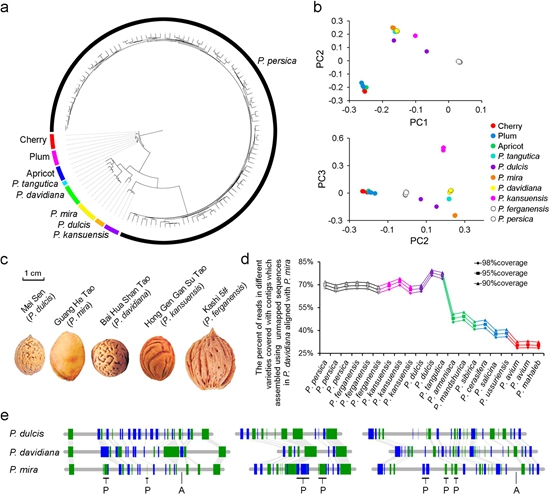Pan-genomic Map of Wild Peach Germplasm Released
Recently, the peach Resources and Breeding Innovation Team of Zhengzhou Fruit Research Institute, Chinese Academy of Agricultural Sciences, in cooperation with domestic and foreign research teams, has released the high-quality pan-genome of wild peach species, and identified the resistance genes of wild peach species, which is of great significance to the peach industry structure adjustment, green development and ‘going up the mountain and down to the benchland’. The results are published in BMC Biology.
Peach and its four wild relatives are distributed in a large number of natural populations in China. P. mira is mainly distributed in the Qinghai-Tibet Plateau, P. kansuensis is mainly distributed in the Hexi Corridor of Gansu Province. P. davidianais distributed in the whole country, concentrated in the Taihang Mountain and Yanshan Mountains,. P. ferganensis is mainly distributed in Xinjiang. After a long period of adaption in the natural environment, wild relatives of P. persica. have acquired precious resistance quality. For example, P. mira is resistant to low temperature and high altitude stress, P. davidianais is resistant to peach aphid and cold, P. kansuensis is resistant to root-knot nematode.
In this study, we constructed high-quality genomic maps of four wild peach species, and found that the variation loci were concentrated in the genome-environment interaction regions.
It was revealed that the number of resistance genes in peach increased significantly during the evolution, and the analysis of genome fragment source indicated that P. davidianais was probably derived from the hybridization of P. mira and P. communis, and the introduction of new genes was the reason for the increase of resistance genes, thus revealing the molecular mechanism of comprehensive resistance of P. davidianais.L.
A NBS gene of root-knot nematode resistance to C. australis was identified on the top of chromosome 2 of peach ‘Honggengansutao’ by BSA combined with comparative genome analysis. The 35bp mutation in the promoter region was found as a key mutation leading to the formation of resistance.
Through population selection analysis, 231 genes related to plateau adaptability were identified. Combined with transcriptome analysis, a CBF gene among the selected genes was found to be associated to low temperature stress, and a 9bp variation was found in the promoter region of the same gene, which is closely related to the formation of cold resistance.
The resistance genes identified in this study laid a theoretical foundation for revealing the evolution and environmental adaptability of peach, and provided technical support for the development of molecular markers and resistance breeding. Cao Ke and Li Yong are the co-first authors of this paper, and Wang Lirong and Cao Ke are the corresponding authors. The materials for this study were supported by the National Horticulture Germplasm Resources Center. This work was supported by the National Key Research and Development Program (2019YFD1000203), and the Agricultural Science and Technology Innovation Program (CAAS-ASTIP-2019-ZFRI-01).

Genetic relationship of peach wild relatives
By Li Yong(liyong02@caas.cn)
-
 Apr 18, 2024Opening Ceremony of the Training Workshop on Wheat Head Scab Resistance Breeding and Pest Control in Africa Held in CAAS
Apr 18, 2024Opening Ceremony of the Training Workshop on Wheat Head Scab Resistance Breeding and Pest Control in Africa Held in CAAS -
 Apr 03, 2024IPPCAAS Co-organized the Training Workshop on Management and Application of Biopesticides in Nepal
Apr 03, 2024IPPCAAS Co-organized the Training Workshop on Management and Application of Biopesticides in Nepal -
 Mar 28, 2024Delegation from the School of Agriculture and Food Science of University College Dublin, Ireland Visit to IAS, CAAS
Mar 28, 2024Delegation from the School of Agriculture and Food Science of University College Dublin, Ireland Visit to IAS, CAAS -
 Mar 25, 2024Director of World Food Prize Foundation visited GSCAAS
Mar 25, 2024Director of World Food Prize Foundation visited GSCAAS -
 Mar 20, 2024Institute of Crop Sciences (ICS) and Syngenta Group Global Seeds Advance Collaborative Research in the Seed Industry
Mar 20, 2024Institute of Crop Sciences (ICS) and Syngenta Group Global Seeds Advance Collaborative Research in the Seed Industry
